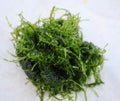Managing the Rate of Growth of Hornwort

Hornwort planting is a little more challenging.
You'll need to give your hornwort a little more support before it grows its anchoring stems to make sure it doesn't float to the surface. Using suction cups to secure the base of the stem to the tank's bottom is a frequent way to achieve this.
By doing this, your plant will be able to fix itself to the ground without endangering the plant itself. You'll be shocked at how quickly this process can go!
Things to be aware of
Once you've introduced hornwort to your aquarium, there isn't much left to take care of. It requires very little upkeep to operate.
But much like anything else in your aquarium, issues might occasionally occur. The solutions to a few frequent problems are listed below.
Managing the Rate of Growth
When introducing hornwort to your aquarium, the key thing you need to pay attention to is how quickly it grows.
It moves quickly.
As a result, there are a few things you must do to keep your plant and the tank healthy. Overall, it requires little attention, though it is not completely hands-off.
You'll need to periodically clip or prune the stems to control how quickly it grows. If you don't do this, your plant will grow into a huge beast very rapidly.
As a result, by obstructing light, the hornwort can keep its tankmates from growing. This clearly affects any other plants you have in your aquarium, but it also poses a health risk to your fish.
The quantity you clip depends on your tank's size, whether you choose to float it, and the species of fish you keep. There is no set rule for this; as long as you follow common sense, everything will be alright.
Last but not least, you need to watch out for hornwort that is encroaching too closely on your filter input. This is simple to see.
Managing Shedding
Your hornwort plant may occasionally lose a little material. If this occurs, simply gather any extra leaves that could obstruct machinery or dirty the water in your tank.
You should identify the problem if this mild shedding develops into a full-blown leaf evacuation. The most likely causes are unfavorable water conditions or inadequate sunlight (which can be too much or too little).
Discoloration
Your hornwort may occasionally change color and turn brown or yellow (both extremely attractive and healthy colors).
Those of you who have dealt with or will deal with brown hornwort should feel at ease right away. Your plant will occasionally turn brown, which is very natural. Don't worry—a healthy amount of light is what's causing this.
But if your hornwort starts to turn yellow, that's cause for alarm. Unfortunately, there isn't one constant offender for whenever this occurs, so you'll need to conduct some investigation to determine the cause.
The usual suspects are a decent place to start (obviously, we're really into the cop lingo). To make it easier for you, here they are:
bad lighting Like any plant, your hornwort will suffer greatly if it doesn't get enough light. Make sure your lamp is functioning properly and that nothing is blocking the light from getting to your plant. Here, a planted hornwort and dirty water are a surefire prescription for disaster.
water caliber. Check your water quickly to make sure everything is in order in your tank. Keep an eye out for your plant turning yellow, as this is a common sign of a lack of iron.
Hornwort: How to Grow It
Here is the incredibly easy procedure you must follow if you want to propagate your hornwort and make your plant the gift that keeps on giving:
Step 1 is to cut off a side stem.
Step 2: Insert this newly separated stem in another location within the tank (either by floating it or planting it).
Watch your new hornwort plant grow in the third step!
Yes, it is actually that simple.
This ought to show how this plant has thrived (and become invasive) in the wild. While it can be a problem in some regions of the world, it makes hornwort propagation simple.
Conclusion
By this point, you should have a solid understanding of hornwort, including how to care for them in your tank.As you've probably figured out by now, they don't need much care and are good for your tank in many ways.
Hornwort is a fantastic option if you're thinking about adding a plant to your freshwater aquarium.
















